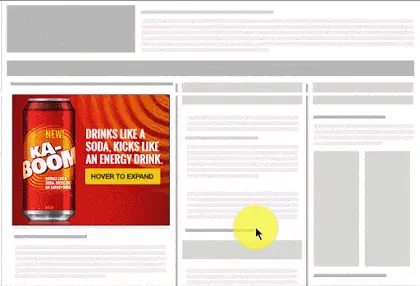You love your readers and always try to give your best to them. Whether it’s content or the ads, everything should be top-notch. We know this as we want the same for you. Quality content is king, and you are at the top of the heap here. But what about the ads? Are you settling for bland, uninspiring banner ads that are too easy for users to ignore?
While banner ads have been a popular advertising format for years, the phenomenon of banner blindness is becoming increasingly prevalent. Users are becoming more adept at tuning out these static, unengaging ads, leaving publishers struggling to drive the needed engagement and revenue.
Well, here we are with a solution- use Rich Media ads. Rich media ads are shaking up the advertising industry by adding a twist of creativity and interactivity that captivates users’ attention and delivers better engagement rates. With features like video, audio, and animation, rich media ads offer a unique opportunity for publishers to break through the noise and create a memorable user experience.
In this comprehensive guide, we’ll explore everything you need to know about rich media ads and how they can help you take your advertising game to the next level.
Table of Contents
What Are Rich Media Ads?
Rich Media ads are ad formats that combine text, images, audio, video, and any other web elements to provide an interactive ad experience to the user. Unlike traditional banner ads, which are static images or text-based, rich media ads engage your audience and provide an immersive experience. These ads can be anything from a simple video ad to a fully interactive game that users can play within the ad unit.
Rich media ads are built using HTML5 and JavaScript so they can float, expand, etc. Thus, the interactive nature of rich media ads draws in the audience, keeping them engaged with the ad while encouraging them to take action toward the established goal. Rich media ads example:
These ads are highly customizable and can be designed to match the look and feel of your website or app, making them appear more seamless and less intrusive to users. Plus, they’re becoming increasingly popular among advertisers, so incorporating them into your content can help you stand out. The best part is that audience behavior, like numbers of expansions, exits, and video completion rates (VCR), can be tracked and reported. This, in turn, helps determine the ad campaign’s success.

Features of Rich Media Ads
There are plenty of rich media ad formats to explore. Before you dive right in, though, it’s important to know which features are available with them.
- Advanced animations
- Instant user interaction (due to the presence of dynamic motion)
- Flash games that can be played instantly
- Better ad quality and content
- Technically advanced
- Increased brand awareness and higher ROI.
Difference Between Standard Ad and Rich Media Ad
| Standard Ads | Rich Media Ads |
| Standard ads are simple. They generally include texts with a visual element, such as a logo or a graphic. | Rich Media ads are creative and typically have flash games, polling, videos, etc. |
| These ads are typically small in file size, usually less than 200k. | Rich media ads tend to be larger due to high-quality videos, images, and interactive elements. |
| The ad is static with minimal to no interactive elements and is limited to standard web technologies like HTML and CSS. | These dynamic ads offer interactive features such as expansion, float, video playback, and good control. They can coexist with advanced technologies like HTML5, Java, and JavaScript, which allow for even more creative and interactive elements. |
| Standard ads have limited functionality, and clicking on the ad takes the user to the advertiser’s page. | Rich media ads offer more interactions and user engagement, and users can interact with the ad in various ways, such as pausing, closing, or expanding the ad. The landing page is not the only goal of the ad. Rich media ads can be designed to keep the user engaged with the ad and deliver the message even after they leave the ad. |
| Standard ads are designed to deliver a simple message and typically offer a low click-through rate (CTR). | Rich media ads are designed to offer an immersive experience, increase engagement, and improve the overall user experience, leading to higher CTR and conversion rates. Rich media ads are capable of increasing brand awareness and ROI through the use of interactive elements and engaging content. |
| Standard ads can be created and deployed quickly, often using templates and simple designs. | Rich media ads require more time and resources, as they often involve developing custom interactive elements and multimedia content. |
| Standard ads are typically less expensive to create and distribute, requiring less time and resources. | Rich media ads can be more expensive to create and distribute due to the higher cost of developing custom interactive elements and multimedia content. |
| Standard ads are limited to basic targeting options such as demographics and interests. | Rich media ads offer advanced targeting options such as geographic location, device type, and behavior, allowing for a more personalized and effective advertising experience. |
Types of Rich Media
Here’s a fact. Rich Media ads aren’t as technical as you think. Even a video is considered a rich media ad. Here we listed the top rich media ads that you can run:
1. Banner (Motion Poster)
If you have an ad creative that is fixed, then you can call it a banner. And if it’s dynamic, it is indeed a rich media ad. As you have guessed, banners are the most common type of rich media ads and have higher demand too. Since everyone supports it, more advertisers tend to run it.
Demand: High. Programmatic digital display ads will account for 19% of total digital display advertising last year (in the US region) in 2022, and it will continue to go up. If you wonder why advertisers are spending billions on banners, it is relatively cheap and suitable for campaigns like brand awareness, seasonal offers, etc.
CPM: Medium to High (depends on the audience, publisher, viewability, and other factors). Make sure you segment the audience and employ a first-party data strategy to get the best possible CPMs. Without a doubt, header bidding can be a game-changer.
Loading time: Low. If there are no heavy files to render, loading is quick.
The technology used: Polite download.
2. Interstitial Ads
An interstitial ad is a rich media format that includes many different elements. It supports videos, banners, and other HTML5-based elements. Interstitial ads are mostly full-screen and are displayed at natural transition points (during the pause between different levels in a game or between activities).
Interstitial ads can move with the content or maintain a locked position as a user scrolls on the web page. The “Locked” option is available at the ad trafficking stage. When an interstitial ad is displayed, there is an option to either click on the ad and reach the respective page or close it and return to the webpage.
Demand: High. When advertisers realize interstitial ads can yield better viewability and brand recall, the investment in the format started to increase. Almost 20% of the demand is for interstitials.
CPM: High. As the viewability is high, CPMs are usually higher for interstitial ads. However, you need to make sure the user experience isn’t hampered. Remember, almost all internet users hate to see pop-ups, and especially when it is relevant, you might lose readers.
Loading Time: High.
Technology Used: Video, Polite download, HTML5.
Related Read: What are Web Interstitial Ads and How to get started with them?
3. Expandable Ads
As the name suggests, an expandable ad expands according to its placement on the web page. It is a location-based ad. For example, if an ad is placed on the right side of the web page, it automatically expands towards the left side of the page when triggered by user behavior (a mouse click or tap) and vice versa.
Demand: Low as the format is relatively new to advertising.
CPM: High. MDE ads are user-initiated, depicting that the user is actually interested in viewing the complete or expanded version of the ad.
User Engagement: High. Obviously, the ads, when expanded, will lead to the best possible recall a brand could have.
Loading Time: High. With the stack of files, images, videos, and audio, loading will take time.
4. Pushdown Ads
Pushdown ads don’t expand in size; it loads as a teaser on the webpage, and on click, tap, or hover, the ad pushes the web page’s content to reveal a larger ad creative. These ads support a variety of engaging creatives that don’t hide the content, thus getting more views than overlaying ad units.
Demand: Medium. The format is new yet gaining traction as it resembles a traditional leaderboard.
CPM: High. As mentioned earlier, a user-initiated ad will tend to have better CPMs.
User Engagement: High.
Loading Time: High. Because of the video and audio files associated with the ad, the user may experience a delay in loading the ad.
Do Advertisers Prefer Rich Media?
As the competition is at its peak, marketing professionals have realized that reaching the targeted audience is difficult. Buyers are equally aware and are conducting their purchasing research. Viewers tend to get irritated when they are overloaded with different types of boring traditional ads; this causes a waste of both time and money. Rich Media is a powerful tool, offering greater performance than most traditional ads.
Many advertisers prefer rich media ads due to their ability to deliver a highly engaging and interactive experience, advanced targeting options, and the ability to deliver complex messages. These ads are measurable; it allows advertisers to track and evaluate a variety of important browsing behaviors (for example, the percentage of videos viewed). While they may require more time and resources to create, the potential for higher ROI often makes them a worthwhile investment for advertisers.
What the Future Beholds
The introduction of rich media ads has transformed the advertising industry. These ads provide an immersive and interactive experience for users with advanced techniques like flash games, videos, and interactive features. They offer a unique way for advertisers to promote their brand without interrupting the user experience.
Rich media ads have received a positive response from users, resulting in increased brand awareness, higher call-to-action rates, and better ROI for advertisers. As a publisher, always keep track of the best ad formats and demand. Else, let us do the job.
To maximize the effectiveness of advertising campaigns, it is essential to be creative and innovative. Rich media ads provide a platform for publishers to deliver a seamless and engaging advertising experience. By embracing this future of advertising, publishers can stay ahead of the game and offer a more valuable service to advertisers and users alike.
FAQs
Q1. How to create rich media ads?
Various online tools and platforms are available to create rich media ads, including Google Web Designer, Adobe Animate, and HTML5 Maker. However, hiring a professional or using a rich media ad provider is recommended to ensure high-quality results.
Q2. How do rich media ads work?
Rich media ads combine advanced features like interactive elements, animations, videos, and more to create an engaging user experience. They are designed to grab the user’s attention and deliver a more immersive advertising experience.
Q3. Are rich media ads the same as video ads?
No, rich media ads are not the same as video ads. While video ads are typically pre-recorded video content, rich media ads include various interactive features like animations, games, and more to provide an engaging experience for the user.























